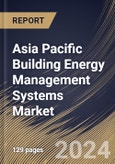BEMS serves as a powerful tool for energy monitoring and data analytics. By integrating sensors, meters, and other monitoring devices, BEMS collects real-time data on energy consumption within a building. This data is then analyzed to identify patterns, trends, and areas of inefficiency. Energy managers and facility operators can gain valuable insights into how and when energy is used, allowing for informed decision-making and targeted improvements. One of the primary uses of BEMS is optimizing HVAC systems. BEMS monitors and controls temperature, humidity, and air quality based on occupancy, weather conditions, and other factors. By dynamically adjusting HVAC settings, BEMS ensures that energy is used efficiently, preventing unnecessary heating or cooling when spaces are unoccupied and adapting to changing conditions in real-time.
BEMS is crucial in lighting control, contributing to energy efficiency and occupant comfort. Smart lighting systems integrated with BEMS can automatically adjust light levels based on natural daylight, occupancy, and time of day. This minimizes energy usage while improving the comfort and productivity of building occupants. BEMS helps manage peak energy demand by strategically controlling and optimizing energy usage during peak periods. BEMS can implement demand response strategies by identifying peak load times, such as load shedding or shifting non-essential energy-intensive processes to off-peak hours. This reduces electricity costs and contributes to the stability of the overall energy grid.
The Asia Pacific region has witnessed substantial population growth and a significant influx of people into urban areas. According to the report titled Cities as Engines of Growth, published in 2022 by the Government of India, the population of urban areas in India is projected to have increased approximately fourfold, from 109 million in 1970 to 460 million in 2018. The country is projected to experience an additional 416 million inhabitants in its urban areas by 2050, resulting in a 50 percent urban population share. It is already the second-largest urban community globally. Similarly, as per the State Council of China, urbanization has accelerated rapidly throughout China in recent years, with the National Bureau of Statistics estimating that the rate increased to 64.72 percent last year. As of the end of 2022, 914 million people were living in cities, an increase of 12.05 million from 2021. Therefore, due to the above-mentioned factors, the market will grow significantly in this region.
The China market dominated the Asia Pacific Building Energy Management Systems Market by Country in 2022, and would continue to be a dominant market till 2030; thereby, achieving a market value of $1,485 Million by 2029. The Japan market is registering a CAGR of 10.9% during (2023 - 2030). Additionally, The India market would showcase a CAGR of 12.2% during (2023 - 2030).
Based on Category, the market is segmented into Software, Hardware, and Service. Based on End-User, the market is segmented into Residential, Commercial & Institutional, and Industrial. Based on countries, the market is segmented into China, Japan, India, South Korea, Singapore, Malaysia, and Rest of Asia Pacific.
List of Key Companies Profiled
- ABB Ltd.
- General Electric Company
- Honeywell International, Inc.
- Hitachi, Ltd.
- Siemens AG
- Schneider Electric SE
- Emerson Electric Co.
- Rockwell Automation, Inc.
- Eaton Corporation PLC
- mCloud Technologies Corp.
Market Report Segmentation
By Category- Software
- Hardware
- Service
- Residential
- Commercial & Institutional
- Industrial
- China
- Japan
- India
- South Korea
- Singapore
- Malaysia
- Rest of Asia Pacific
Table of Contents
Companies Mentioned
- ABB Ltd.
- General Electric Company
- Honeywell International, Inc.
- Hitachi, Ltd.
- Siemens AG
- Schneider Electric SE
- Emerson Electric Co.
- Rockwell Automation, Inc.
- Eaton Corporation PLC
- mCloud Technologies Corp.








